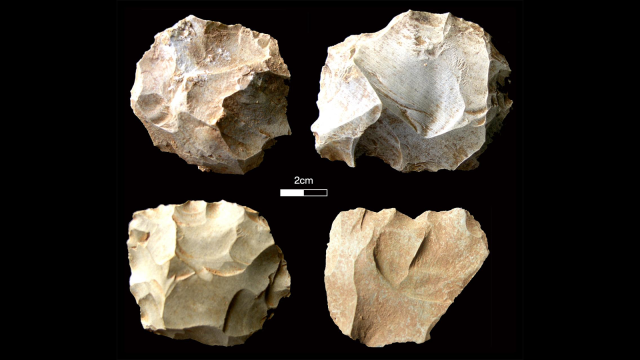Humans may have continued to thrive in spite of a supervolcano eruption 74,000 years ago, according to a new study. The finding could have important implications for our understanding of human history.
Researchers in based in Australia, Germany, the United Kingdom, and India found evidence of stone tools and other artifacts in the Dhaba locality on northern India’s Son River. The sites date to between approximately 80,000 and 65,000 years ago, encompassing the time of the infamous Toba super-eruption. This discovery could help provide a more accurate picture of how early humans spread from Africa eastward to the Indian subcontinent and Australasia.
The Toba eruption is at the centre of a debate surrounding human history. Sediment records reveal approximately 74,000-year-old volcanic “tuff,” rock made from deposited volcanic ash, the result of an eruption 100 times stronger than any other recorded eruption and centered over the current location of Indonesia’s Lake Toba. Some archaeologists theorise that such an event could have led to a bottleneck in the human population, killing off lots of people in the resulting volcanic winter and delaying early humans’ spread into southeast Asia and Australasia.
There are few human fossils in south or southeast Asia to confirm or rule out the theory, so researchers have focused on other lines of evidence, such as modern DNA or stone tools. But the new finds from a trio of excavations at the Dhaba sites could provide the needed evidence.
The researchers uncovered chert, limestone, and mudstone tools that had been flaked with the Levallois technique, a means by which archaeologists think early humans chipped stones into points, knives, scrapers, and other tools. The tools were found in sediment dated to approximately 80,000 to 65,000 years ago, and the tools from the younger sediment appear to have been shaped using more advanced techniques than the older ones. They mirror similar artifacts found in sites in Africa and Arabia, according to the paper published in Nature Communications.
According to the researchers, this is evidence that the Toba event didn’t halt human progress—that during one migration event, Homo sapiens left Africa in a wave 100,000 years ago and travelled eastward along the southern coast of Asia until reaching Australasia.
“Our new findings contribute to a revised understanding of the global impact of the Toba super-eruption. While the Toba super-eruption was certainly a colossal event, global cooling may have been less significant than previously thought,” University of Queensland professor Chris Clarkson and Max Planck Institute for the Science of Human History professor Michael Petraglia wrote in an article published in The Conversation.
This is just one line of evidence; we don’t know what else is out there or what the eruption might have destroyed. And, the authors write, only human fossil evidence would prove without a doubt that there were actually humans present at these sites (it’s possible, for example, that another hominin species made these tools). Still, the finds are corroborated by fossil evidence in China and Southeast Asia dating to 80,000 and 73,000 to 63,000 years ago, respectively, as well as stone tool technology along the southern coast of Asia and genetic evidence written into the modern genome.
One thing is for sure: However catastrophic the Toba event was, human beings survived it and are still around today.
